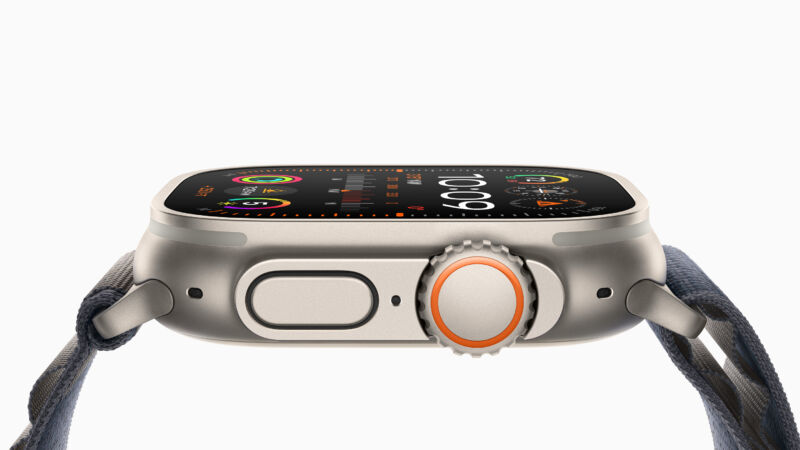
Apple
Starting today, if you buy an Apple Watch Series 9 or Watch Ultra 2 it won’t be able to tell you your blood oxygen levels, a feature that Apple heavily touted when first introducing the capability in 2020. Although the watches will be less capable than watches of the same model sold before today, Apple is selling the pared-down watches at the same prices as before.
On Wednesday, the US Court of Appeals for the Federal Circuit denied [PDF] Apple’s request that an import ban on the smartwatches be lifted for the duration of Apple’s appeal of the ruling that blocked the watches. Apple expects its appeal to take at least a year to be resolved.
In its ruling, the court said:
Our determination is governed by four factors: (1) whether the movant has made a strong showing of likelihood of success on the merits; (2) whether the movant will be irreparably harmed absent a stay; (3) whether issuance of the stay will substantially injure the other parties interested in the proceeding; and (4) where the public interest lies.
In January 2023, the US International Trade Commission (ITC) ruled that Apple Watches infringe two patents for light-based pulse oximetry functionality and components owned by California-headquartered Masimo.
After US President Joe Biden declined to veto the ruling, Apple filed an appeal and pulled the watches on December 21. The company received a temporary stay that enabled it to sell the watches with the questioned capabilities from December 27 until 5 pm ET yesterday. But yesterday’s ruling resulted in the stay being lifted, forcing Apple to either stop selling the watches or to continue selling them but with the disputed feature removed.
When reached for comment, an Apple spokesperson told Ars Technica:
Pending the appeal, Apple is taking steps to comply with the ruling while ensuring customers have access to Apple Watch with limited disruption. These steps include introducing a version of Apple Watch Series 9 and Apple Watch Ultra 2 in the United States without the Blood Oxygen feature. There is no impact to Apple Watch units previously purchased that include the Blood Oxygen feature.
In a statement shared by Bloomberg today, Masimo CEO Joe Kiani said that Wednesday’s decision “affirms that even the largest and most powerful companies must respect the intellectual rights of American inventors and must deal with the consequences when they are caught infringing others’ patents.”
Same watches, different abilities
Starting today, Apple will only sell the Watch Series 9 and Ultra 2, which both came out in September, with a US Customs and Border Protection-approved software workaround that disables blood oxygen monitoring capabilities. These watches will be available at Apple’s physical and online stores, Apple said. They also have part numbers ending in “LW/A” as per updated Apple support materials.
Users of newly purchased Series 9 and Ultra 2 smartwatches will still have a blood oxygen icon on their watch, but upon tapping the icon, the watch will say, “The Blood Oxygen app is no longer available. Learn more in the Health app on your iPhone.” Once they go to the Health app, users can access a support article on Apple’s website, explaining the situation.
Apple’s general product page for the Apple Watch and its websites for the Series 9 and Ultra 2 now include tiny footnotes way down at the bottom noting that its watches no longer have the blood oxygen monitoring capabilities that they were announced with. When asked why the watches aren’t any cheaper without pulse oximeter functionality, Apple’s rep said that pricing isn’t based on a single feature. It’s worth noting that the watches haven’t become cheaper to make, as they still have the same components as before.
Since the US ITC’s ruling only affects the US, Apple will continue selling the Watch Series 9 and Ultra 2 with blood oxygen monitoring capabilities outside of the US.
Apple didn’t respond to Ars Technica’s questions asking if it will redesign its watches so that they can offer blood oxygen monitoring without infringing on any patents. On Tuesday, Bloomberg reported that Apple has “been working on a software update that changes the blood-oxygen app and its algorithms in a way that might circumvent” patent infringement but keep the feature.

